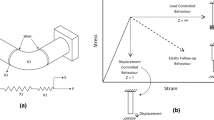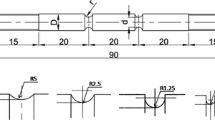Abstract
In structural integrity analysis of components operating at high temperature, it is important to understand whether the presence of residual stresses lead to failure [1]. Accurate prediction of the creep crack initiation is needed in structural integrity assessments of components. General assessment of structures uses the experimental data obtained from laboratory test specimens subjected to either displacement or load tests but in actual operating condition, components are subjected to both inherent residual stresses and applied load. In the current research work, two test rigs are designed and tests are performed to understand the effects of EFU, long-range residual stress and external applied load on creep behaviour of 316H stainless steel. Results obtained show that, for the same total initial reference stress, the time for crack to grow is lower in the case of mixed loading conditions compared to load-controlled tests. The longer crack growth times are a consequence of the relaxation and redistribution of the residual loads in the structure. The initiation time is also a function of the elastic follow-up.
Access this chapter
Tax calculation will be finalised at checkout
Purchases are for personal use only
Similar content being viewed by others
References
Shirahatti AM, Smith DJ (2015) The effects of long-range residual stress, elastic follow-up and applied load on creep crack incubation and material toughness. J Strain Anal Eng Des, JSA Golden Issue, July 2015, pp 1–15
Robinson EL (1955) Steam piping design to minimize creep concentration. Trans ASME 77:1147–1162
Shirahatti AM, Truman CE, Smith DJ (2013) Experiments to determine the influence of residual stress and elastic follow-up on creep crack initiation. In: Proceedings of the ASME 2013 pressure vessels & piping conference, Paris, France
British Energy Generation Ltd. (2003) Assessment procedure for the high temperature response of structures. R5 Standards, Issue 3
Shirahatti AM, Smith DJ (2019) A novel creep test rig to study the effects of long-range residual stress, elastic follow-up and applied load. J Braz Soc Mech Sci Eng 41(230):1–12
Bouchard PJ, Withers PJ, McDonald SA, Heenan RK (2004) Quantification of creep cavitation damage around a crack in a stainless steel pressure vessel. Acta Mater 52(1):23–34
Shirahatti AM (2014) A novel test rig to study the effects of elastic follow-up, long range residual stress and applied load on creep crack initiation. PhD thesis, University of Bristol, United Kingdom
Kapadia P, Davies CM, Dean DW, Nikbin KM (2012) Numerical simulation of residual stresses induced in compact tension specimens using electron beam welding. In: Proceedings of the ASME 2012 pressure vessels & piping conference, Toronto, Ontario, Canada
Dean DW, Gladwin DN (2007) Creep crack growth behavior of Type 316H steels and proposed modifications to standard testing and analysis methods. Int J Press Vessels Pip 84:378–395
Fookes AJ (2003) Assessment of crack growth in steels at high temperature. PhD thesis, Bristol University, United Kingdom
Gladwin DN, Allport L, January (2010) The constant static displacement controlled creep crack growth response of 316H stainless steel header material. Technical report, British Energy Generation Ltd., Report No. E/EAN/BDBB/0024/AGR/06
Hadidi-Moud S, Smith DJ (2008) Use of elastic follow-up in integrity assessment of structures. In: Proceedings of the ASME 2008 pressure vessels & piping conference, Chicago, Illinois, USA
Aird CJ, Mahmoudi AH, Mirzaee Sisan A, Truman CE, Smith DJ (2006) Generating well defined residual stresses in laboratory specimens. In: Proceedings of the ASME 2006 pressure vessels & piping conference, Vancouver, BC, Canada
Shirahatti AM, Wang Y, Truman CE, Smith DJ (2013) A new method of introducing long range residual stresses to study creep crack initiation. In: 13th international conference on fracture, Beijing, China
Hossain S, Truman CE, Smith DJ (2011) Generation of residual stress and plastic strain in a fracture mechanics specimen to study the formation of creep damage in type 316 stainless steel. Fatigue Fract Eng Mater Struct 34:654–666
Wang YQ, Coules HE, Truman CE, Smith DJ (2018) Effect of elastic follow-up and ageing on the creep of an austenitic stainless steel. Int J Solids Struct 135:219–232
Kapadia P, Davies CM, Dean DW, Nikbin KM (2015) Assessment of creep crack growth due to assessment of creep crack growth due to secondary and combined loading. Transactions, SMiRT-23, Manchester, United Kingdom
Khayatzadeh S, Tanner D, Truman CE, Flewitt P, Smith DJ (2017) Influence of thermal ageing on the creep of a P92 martensitic steel. Mater Sci Eng A 708:544–555
American Society for Testing and Materials (2000) Standard test method for measurement of creep crack growth rates in metals. ASTM E1457-00
R6 Revision 4 Amendment 8 (2010) Assessment of the integrity of structures containing defects. BEGL procedure
Acknowledgements
The author gratefully acknowledges EDF Energy, United Kingdom for the financial support for this work and research facility provided by the University of Bristol, United Kingdom. The author also acknowledges Dr. David Dean and Mr. Mike Spindler of Structural Integrity Group at EDF Energy, for lending their expertise and advice.
Author information
Authors and Affiliations
Corresponding author
Editor information
Editors and Affiliations
Rights and permissions
Copyright information
© 2021 Springer Nature Singapore Pte Ltd.
About this paper
Cite this paper
Shirahatti, A. (2021). Experimental Study to Understand the Effect of Residual Stress and Applied Load on Creep Relaxation. In: Seetharamu, S., Jagadish, T., Malagi, R. (eds) Fatigue, Durability, and Fracture Mechanics. Lecture Notes in Mechanical Engineering. Springer, Singapore. https://doi.org/10.1007/978-981-15-4779-9_45
Download citation
DOI: https://doi.org/10.1007/978-981-15-4779-9_45
Published:
Publisher Name: Springer, Singapore
Print ISBN: 978-981-15-4778-2
Online ISBN: 978-981-15-4779-9
eBook Packages: EngineeringEngineering (R0)




